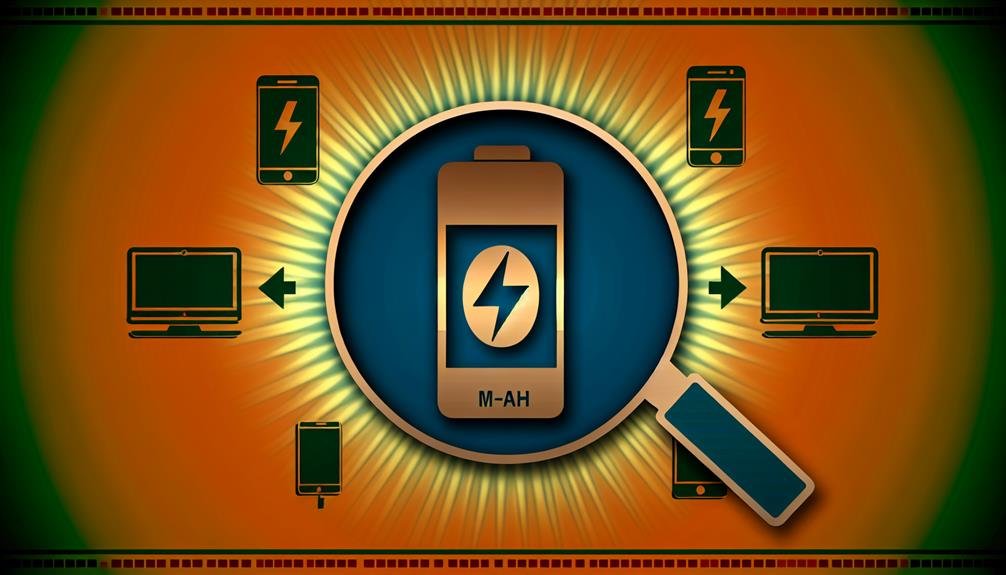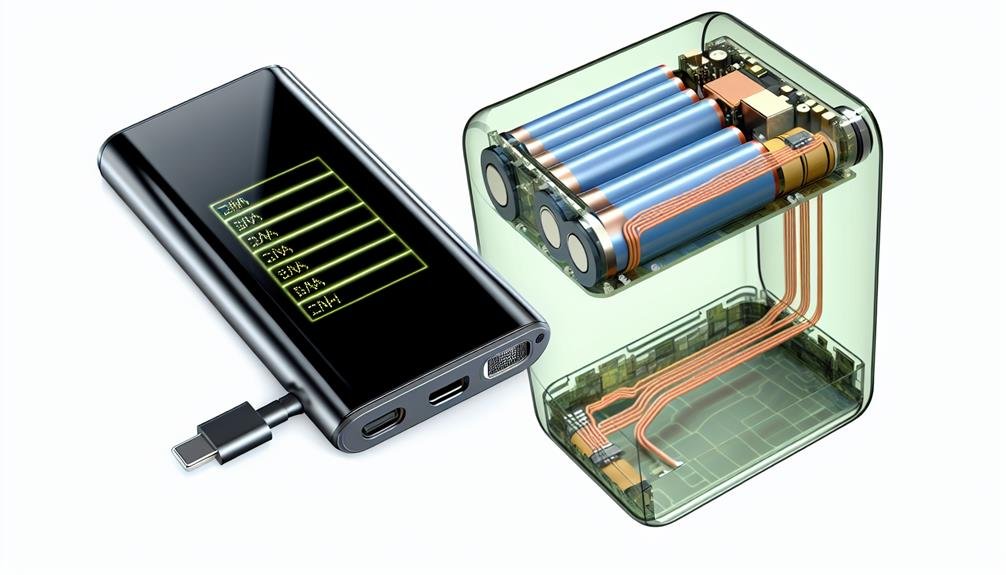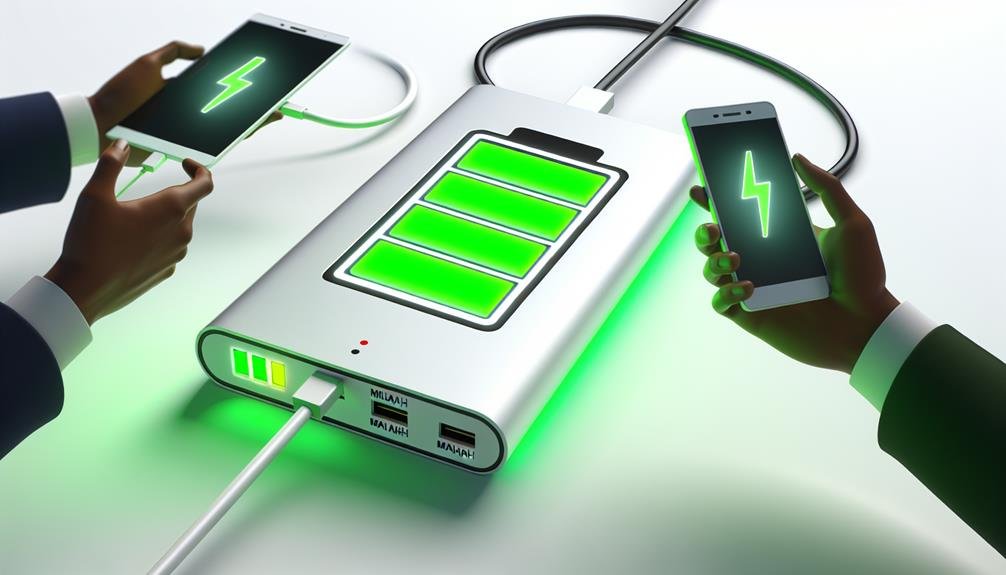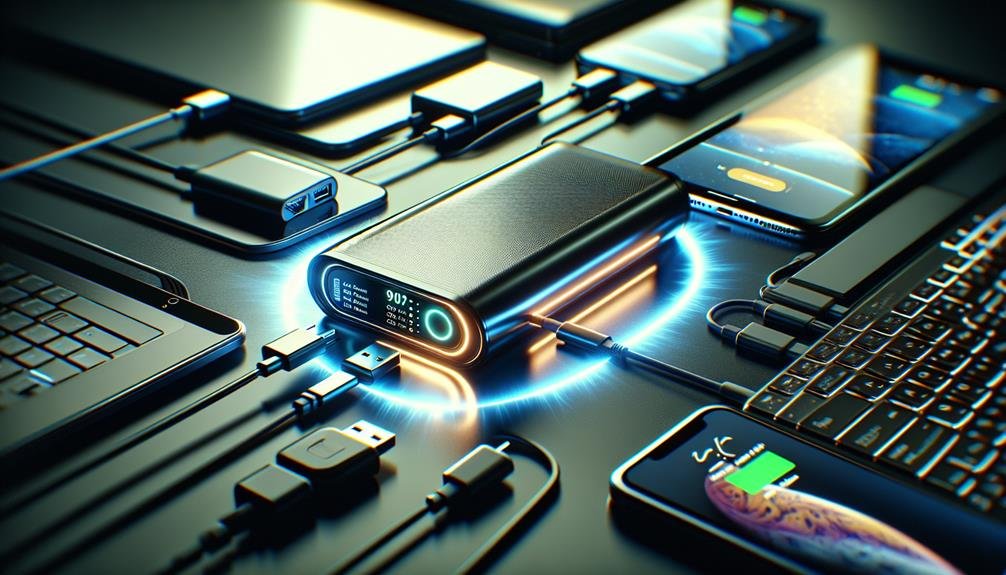mAh, or milliamp-hours, measures a power bank's capacity. A higher mAh means more energy storage, translating to more charging cycles for your devices. For instance, a 10,000 mAh power bank offers more charges than a 5,000 mAh one. It also supports faster charging speeds and can handle device power consumption more efficiently. When selecting a power bank, consider the balance between capacity and portability, and make sure it has essential safety features like overcharge protection. To figure out charging compatibility and efficiency, knowing your device's battery mAh is important. Want to optimize your power bank usage?
Definition of Mah

Understanding the definition of mAh (milliampere-hour) is necessary when evaluating the capacity and performance of a power bank. mAh measures the power capacity of a battery, indicating how much charge it can store. A higher mAh value means the power bank can theoretically hold more energy, extending battery life for your devices. For instance, a power bank rated at 10,000 mAh can provide more charging cycles than one rated at 5,000 mAh, assuming energy efficiency remains consistent.
When evaluating charging speed, mAh becomes critical. It's not just about how much power the battery can hold, but also how quickly it can deliver that power to your device. Higher mAh-rated power banks often support faster charging speeds, which is essential for those who need their devices ready to go in a short time. However, always verify that your power bank's energy efficiency aligns with your device's requirements to prevent overheating and ensure safe operation.
Importance of Mah in Power Banks
Assessing the mAh rating in power banks isn't just about capacity; it plays a crucial role in determining how long and efficiently your devices will remain powered. The mAh (milliampere-hour) rating directly impacts the charging speed and overall user experience. A higher mAh signifies greater energy storage, allowing for multiple or extended charges for devices. However, striking a balance between portability and capacity is crucial. A high mAh power bank could be bulky, affecting its ease of portability.
| mAh Rating | Estimated Charges | Portability |
|---|---|---|
| 5,000 mAh | 1-2 charges | High |
| 10,000 mAh | 3-4 charges | Moderate |
| 20,000 mAh | 6+ charges | Low |
Charging speed is another crucial factor. Power banks with higher mAh ratings often support faster charging capabilities, ensuring your devices are prepared when you need them. However, always verify if the power bank supports quick charge technology to maximize efficiency.
Safety is paramount, particularly with high-capacity power banks. Overloading or overheating can pose risks. It is vital that your power bank includes built-in safety features such as overcharge protection and short-circuit prevention. Balancing these factors will assist you in selecting the appropriate power bank for your requirements, guaranteeing both safety and convenience.
Calculating Battery Capacity

To calculate a power bank's battery capacity, you'll need to take into account the mAh rating relative to your device's power requirements. Begin by understanding the mAh (milliampere-hour) rating of your device's battery. This rating indicates how much charge a battery can hold. For example, if your smartphone has a 3000mAh battery, it requires a corresponding amount of charge to be fully powered.
Next, compare the power capacities of different power banks. If a power bank has a 10,000mAh rating, theoretically, it can charge a 3000mAh smartphone battery approximately three times (10,000mAh ÷ 3000mAh). However, it's essential to account for energy loss during the transfer process, typically around 20-30%. Thus, a 10,000mAh power bank might effectively provide about 7000mAh of usable power.
Understanding battery life is important for safely managing your devices. Always make sure that the power bank's capacity aligns with the energy requirements of your devices. Overloading a power bank or frequently draining it completely can reduce its lifespan and potentially pose safety risks. By systematically comparing power capacities and calculating the required mAh, you'll guarantee your devices remain charged and operable without compromising safety.
Choosing the Right Mah for Your Needs
When selecting the appropriate mAh for your requirements, consider the power consumption of your devices and the frequency of recharges needed to maintain peak performance. Begin by identifying the battery capacity of each device, typically mentioned in mAh (milliampere-hours). For instance, if your smartphone has a 3,000 mAh battery, a 10,000 mAh power bank could theoretically recharge it slightly over three times, taking into account efficiency losses.
In an mAh comparison, higher capacities indicate more recharges or the capability to power multiple devices. However, this also entails increased size and weight, which may affect portability. Assess your daily usage—whether you require a power bank for brief outings or extended trips—prior to making a decision.
Additionally, comprehend the correlation between mAh and charging speed. While mAh signifies the overall capacity, it does not directly impact how quickly your device will charge. Charging speed is determined by the power bank's output voltage and current (e.g., 5V/2A). Always verify the presence of safety features like overcharge protection and short-circuit prevention, guaranteeing that the power bank complies with international safety standards. This methodical approach safeguards the functionality and safety of your devices throughout their usage.
Mah and Device Compatibility

Understanding mAh and device compatibility ensures that your power bank efficiently meets the energy demands of your gadgets without causing damage. The milliampere-hour (mAh) rating of a power bank directly influences its ability to charge different devices. To guarantee compatibility, match the mAh of the power bank with the battery capacity of your device. For instance, a smartphone with a 3000mAh battery will benefit from a power bank with a minimum of 3000mAh for a full charge cycle.
It's important to take into account mAh and charging speed. Higher mAh ratings generally allow for faster charging since the power bank can deliver more current over time. However, make sure that the power bank's output voltage and current align with your device's specifications to avoid overcharging or overheating, which can shorten the device's battery lifespan.
Frequently Asked Questions
How Does Temperature Affect Power Bank Performance?
When temperature deviates from ideal conditions, it mildly influences thermal regulation, impacting your power bank's performance. Efficiency decreases, causing potential safety concerns. Maintaining ideal temperature guarantees your power bank operates efficiently and reliably.
Can Power Banks With Higher Mah Charge Laptops?
Yes, power banks with higher mAh can charge laptops, but you must confirm power bank compatibility with your laptop's voltage and wattage requirements. Always check the laptop charging capabilities and safety standards before use.
Do Power Banks Degrade Over Time?
Although you might think they last forever, power banks do degrade over time. Their battery capacity and longevity diminish, which affects charging speed and efficiency. Regular use and exposure to extreme conditions can accelerate this process.
What Safety Features Should a Power Bank Have?
When considering a power bank's safety features, make sure it has overcharging prevention, short circuit protection, and high-quality input/output ports. Additionally, verify the battery capacity matches your device's needs to avoid potential hazards.
How Long Does It Take to Fully Charge a Power Bank?
It's a coincidence you asked about charging time because fast charging capabilities greatly impact this. Typically, a power bank charges in 1-8 hours, depending on its capacity and your charger's efficiency. Compare charging speeds for accurate expectations.



